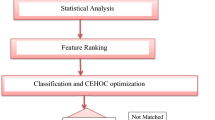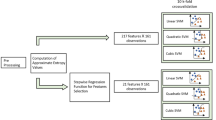Abstract
Chronic alcoholism may damage the central nervous system, causing imbalance in the excitation–inhibition homeostasis in the cortex, which may lead to hyper-arousal of the central nervous system, and impairments in cognitive function. In this paper, we use the Hilbert-Huang transformation (HHT) method to analyze the electroencephalogram (EEG) signals from control and alcoholic observers who watched two different pictures. We examined the intrinsic mode function (IMF) based energy distribution features of FP1, FP2, and Fz EEG signals in the time and frequency domains for alcoholics. The HHT-based characteristics of the IMFs, the instantaneous frequencies, and the time-frequency-energy distributions of the IMFs of the clinical FP1, FP2, and Fz EEG signals recorded from normal and alcoholic observers who watched two different pictures were analyzed. We observed that the number of peak amplitudes of the alcoholic subjects is larger than that of the control. In addition, the Pearson correlation coefficients of the IMFs, and the energy-IMF distributions of the clinical FP1, FP2, and Fz EEG signals recorded from normal and alcoholic observers were analyzed. The analysis results show that the energy ratios of IMF4, IMF5, and IMF7 waves of the normal observers to the refereed total energy were larger than 10 %, respectively. In addition, the energy ratios of IMF3, IMF4, and IMF5 waves of the alcoholic observers to the refereed total energy were larger than 10 %. The FP1 and FP2 waves of the normal observers, the FP1 and FP2 waves of the alcoholic observers, and the FP1 and Fz waves of the alcoholic observers demonstrated extremely high correlations. On the other hand, the FP1 waves of the normal and alcoholic observers, the FP1 wave of the normal observer and the FP2 wave of the alcoholic observer, the FP1 wave of the normal observer and the Fz wave of the alcoholic observer, the FP2 waves of the normal and alcoholic FP2 observers, and the FP2 wave of the normal observer and the Fz wave of the alcoholic observer demonstrated extremely low correlations. The IMF4 of the FP1 and FP2 signals of the normal observer, and the IMF5 of the FP1 and FP2 signals of the alcoholic observer were correlated. The IMF4 of the FP1 signal of the normal observer and that of the FP2 signal of the alcoholic observer as well as the IMF5 of the FP1 signal of the normal observer and that of the FP2 signal of the alcoholic observer exhibited extremely low correlations. In this manner, our experiment leads to a better understanding of the HHT-based IMFs features of FP1, FP2, and Fz EEG signals in alcoholism. The analysis results show that the energy ratios of the wave of an alcoholic observer to its refereed total energy for IMF4, and IMF5 in the δ band for FP1, FP2, and Fz channels were larger than those of the respective waves of the normal observer. The alcoholic EEG signals constitute more than 1 % of the total energy in the δ wave, and the reaction times were 0_4, 4_8, 8_12, and 12_16 s. For normal EEG signals, more than 1 % of the total energy is distributed in the δ wave, with a reaction time 0 to 4 s. We observed that the alcoholic subject reaction times were slower than those of the normal subjects, and the alcoholic subjects could have experienced a cognitive error. This phenomenon is due to the intoxicated central nervous systems of the alcoholic subjects.



Similar content being viewed by others
References
Huang, N. E., and Hen, S. S. P., Hilbert-Huang transform and its applications. World Scientific Publishing Co., Singapore, 2005.
Huang, N. E., Shen, Z., Long, S. R., et al., The empirical mode decomposition and the Hilbert spectrum for non-linear and non-stationary time series analysis. Proc. R. Soc. Lond. Ser. A Math. Phys. Eng. Sci. 454:903–995, 1998.
Wu, M. C., and Huang, N. E., The bimedical data processing using HHT: a review. In: Nait-Ali, A. (Ed.), Advanced biosignal processing. Springer Publishers, Berlin, pp. 335–350, 2009.
Yan, R., and Gao, R. T., A tour of the Hilbert-Huang transform: an empirical tool for signal analysis. IEEE Instrum. Meas. Mag. 10:11–15, 2007.
Rui, F. P., A new tool for nonstationary and NonlinearSignals: the Hilbert-Huang transform in biomedical applications. In: Anthony, N. (Ed.), Biomedical engineering trends in electronics, communications and software. Intech Science Publishers, Austria, pp. 481–504, 2011.
Lin, C. F., and Zhu, J. D., Hilbert-Huang transformation based time-frequency analysis methods in biomedical signal applications. Proceedings of the institution of mechanical engineers, part H. J. Eng. Med. 226:208–216, 2012.
Milan S., Hilbert-Huang Transform and Its Applications in Engineering and Biomedical Signal Analysis. WSEAS International Symposium on Recent Researches in Circuits and Systems.188–195, 2012.
Akin, M., Comparison of wavelet transform and FFT methods in the analysis of EEG signals. J. Med. Syst. 26(3):241–247, 2002.
Porjesz, B., Rangaswamy, M., Kamarajan, C., et al., The utility of neurophysiological markers in the study of alcoholism. Clin. Neurophysiol. 116(5):993–1018, 2005.
Rangaswamy, M., Porjesz, B., Chorlian, D. B., et al., Beta power in the EEG of alcoholics. Biol. Psychiatry 52(8):831–842, 2002.
Rangaswamy, M., Porjesz, B., Chorlian, D. B., et al., Theta power in the EEG of alcoholics, alcoholism. Clin. Exp. Res. 27(4):607–615, 2003.
Campanell, S., Petit, G., Maurage, P., et al., Chronic alcoholism: insights from neurophysiology. Neurophysiol. Clin. Clin. Neurophysiol. 39(4):191–207, 2009.
Sun, Y., Ye, N., and Xu, X., EEG analysis of alcoholics and controls based on feature extration. IEEE. Int. Conf. Sig. Process. 2006.
Jang, H. R., Ko, H. K., Latchoumane, C. F., et al., Comparison of linear and nonlinear functional connectivity in alcoholic patients. IFMBE Proc. 14:1115–1118, 2007.
Ismailii, I. A., Memon, I. A., and Memon, A. A., Time-frequency coherence analysis of alcoholic’s EEG. Sindh. Univ. Res. J. (Sci. Ser.) 44(4):715–716, 2012.
Kumar, Y., Dewal, ML., and Anand, RS., Features extraction of EEG signals using approximate and sample entropy. Proceedings of IEEE Students’ Conference on Electrical, Electronics and Computer Science. 2012.
Parvez, MZ., and Paul, M., Features extraction and classification for ictal and interictal EEG signals using EMD and DCT. Proc. IEEE. ICCIT. 132–137, 2012.
Mustafa, C., Hüseyin, G., Ayhan, I., et al., Determining the appropriate amount of anesthetic gas using DWT and EMD combined with neural network. J. Med. Syst. 39:173, 2015.
Sumathi, S., Beaulah, H. L., and Vanithamani, A wavelet transform based feature extraction and classification of cardiac disorder. J. Med. Syst. 38:98, 2014.
Sen, B., Peker, M., Cavusoglu, et al., A comparative study on classification of sleep stage based on EEG signals using feature selection and classification algorithms. J. Med. Syst. 38:18, 2014.
Lin, C. F., Yeh, S. W., Chien, Y. Y., et al., A HHT-based time frequency analysis scheme in clinical alcoholic EEG signals. WSEAS Trans. Biol. Biomed. 5(10):249–260, 2008.
Lin, C. F., Yeh, S. W., Chang, S. H., et al., An HHT-based time-frequency scheme for analyzing the EEG signals of alcoholics. Nova, USA, 2010.
Lin, CF., Su, JY., and Wang, HM., Hilbert-Huang transform analyses of instantaneous frequencies of FP2 and Fz electroencephalogram signals for alcoholism. Proceeding of 2013 International Conference on Biological, Medical and Chemical Engineering. 579–582, 2013.
Lin, C. F., Yang, B. H., Peng, T. I., et al., Sharp wave based HHT time-frequency features with transmission error. In: Georgi, G., and Theo, A. R. (Eds.), Advance in telemedicine: technologies, enabling factors and scenarios. Intech Science Publishers, Austria, pp. 149–164, 2011.
Zhu, J. D., Lin, C. F., Chang, S. H., et al., Analysis of spike waves in epilepsy using Hilbert-Huang transform. J. Med. Syst. 39:170, 2015.
Acknowledgments
The authors acknowledge the support of the ntou center for teaching and learning, maritime telemedicine teaching and learning probject, and the valuable comments of the reviewers.
Author information
Authors and Affiliations
Corresponding author
Additional information
This article is part of the Topical Collection on Education and Training
Rights and permissions
About this article
Cite this article
Lin, CF., Su, JY. & Wang, HM. Hilbert-Huang Transformation Based Analyses of FP1, FP2, and Fz Electroencephalogram Signals in Alcoholism. J Med Syst 39, 83 (2015). https://doi.org/10.1007/s10916-015-0275-6
Received:
Accepted:
Published:
DOI: https://doi.org/10.1007/s10916-015-0275-6




